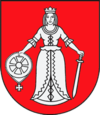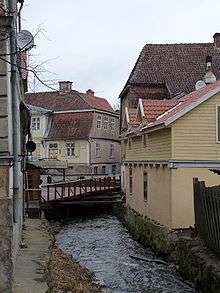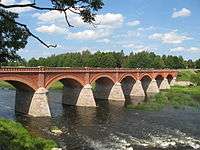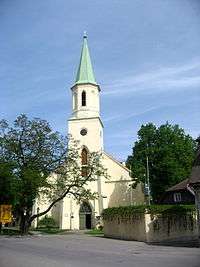Kuldīga
Kuldīga (![]()
Kuldīga | |
|---|---|
Town | |
Town hall of Kuldīga | |
 Flag  Coat of arms | |
 Kuldīga Location in Latvia | |
| Coordinates: 56°58′N 21°58′E | |
| Country | |
| District | Kuldīga Municipality |
| Town rights | 1378 |
| Government | |
| • Mayor | Inga Bērziņa |
| Area | |
| • Total | 13.2 km2 (5.1 sq mi) |
| Population | |
| • Total | 12,981 |
| Time zone | UTC+2 (EET) |
| • Summer (DST) | UTC+3 (EEST) |
| Postal code | LV-330(1–3) |
| Calling code | +371 633 |
| Number of city council members | 11 |
| Website | http://www.kuldiga.lv/ |

Kuldīga was first mentioned in 1242. It joined the Hanseatic League in 1368.[1] In the 17th century, Kuldīga (along with Jelgava (Mitau)) was one of the capitals of the Duchy of Courland.
Kuldīga is an ancient town in Latvia's wester region of Kurzeme with distinctive architecture. Saint Catherine is believed to be the patron saint of Kuldīga, and the oldest church of the town is named after St Catherine. The foundation of the building was laid as early as in 1252. The church has been remodeled a number of times. The small River Alekšupīte runs through the very centre of the Kuldīga old town, along the walls of the houses. The Old Town around the small river itself is the only remaining 17th–18th-century ensemble of this kind in the Baltic states. A 4.5 m high waterfall on the Alekšupīte is the highest in Latvia. The Venta Rapid, a 240-meter wide natural rapid is the widest in Europe. Not far from the rapid is the Kuldīga brick bridge built in 1874, one of the longest bridges of this type in Europe.
Kuldīga was recognized an EDEN destination in 2007.
History
The origin of the ancient town Kuldīga can be explained by its location on the crossroads: the waterways of River Venta and land routes joining the Prussian lands with the lower reaches of River Daugava. The ancient Kuldiga town of Couronians – a fortified castle mound and a settlement were located 3,5 km to the North down the River Venta on its left bank. The castle mound can be observed nowadays still. It is located on a bank of the River Venta on the foreland between the deep gully of the River Veckuldīga and the ancient valley of the Venta. The Site of the Castle itself is located in the several hectare wide area, but together with the Old City of Kuldiga – the area of more than ten hectares. There might have been a port by the River Veckuldīga.
On April 19, 1242 the Livonian Order of Knights received the master's permission to build a castle on the banks of River Venta. As this is the oldest preserved written document where Kuldiga is mentioned, it is considered to be the year of the foundation of Kuldiga. The Castle of the Livonian Order of Knights was built on the left bank of River Venta by the ford, and the dolomite from the riverbed was used as construction material. In 1263, the castle and settlements around it were already mentioned as town Goldingen, and its rights as for a town were based on Riga city rights.
On April 28, 1355, the Order's master Goswin von Herike allocated new land areas. At the same time he attributed a new privilege to the town, as well as a coat of arms with the image of St. Catherine. From 1439 Kuldiga/Goldingen was given a privilege to arrange a market weekly. The town was established by joining the three main populated areas: the town, the small village of the castle (town of the Couronians) and the village on the hill (so called "Kalnamiests" in Latvian) (in the area of Kalna iela today). The Komtur lived in the Castle of Livonian Order together with his twelve brothers being knights and with so-called stepbrothers who took care about the economic life. The Komtur also led the Komturei of Kuldiga, which had also Durbe, Sabile, Skrunda, Aizpute, Alsunga and Saldus along with Kuldiga in possession.
After establishing the Duchy of Courland and Semigallia in 1561, a new period began in the history of Kuldiga. The first duke Gotthard Kettler chose the former order castle to be one of his residences. He and also later other dukes approved the former town rights of Kuldiga by supporting its economic development. When the duke Gotthard died, the dukedom was divided into two parts and till 1618 Kuldiga was the residence of his youngest son Wilhelm and a capital of Kurzeme. The town made profit from trading with Riga and Jelgava because of the taxes on all the goods taken across the bridge. In 1615, the bridge was destroyed by floods, causing a great loss to the town. In the same year, there was a huge fire destroying the major part of the wood construction in the town. After reconstruction of the town, a new market place was established (the Square of the City Council nowadays) and a new Town Hall was built (Baznīcas iela 5 nowadays), which we now name as the old one. So the centre of the town was moved from the old place near by the St. Catherine's Church to the present Square of the City Council. The richest citizens and merchants built their houses around the new centre of the town. In the second part of the 19th century, small industrial companies began to be developed in the town. Some of them became to be factories with more than 100 workers. The largest factory in Kuldiga was the factory "Vulkāns" producing matches (established in 1878 and closed in 2004), and the label of matchboxes had an image of a deer on it. The second largest was the factory of Vintelers Tūki. Besides, such things as needles, cigars, soap, vodka, liqueurs and mineral water were produced in Kuldiga. Beer brewing was the tradition with deep routes – beer was brewed in the order castle, in duke's manors and in the town as well. Lots of new buildings were built in this period of time – not only residential, but also municipal and public buildings. After several centuries, Kuldiga got a new bridge across the River Venta (1873–74), a new Town Hall was built (1868), the Orthodox Parish House and a church in Liepājas iela, a prison (which is a post nowadays), the House of Latvian Society (which is the Centre for Culture nowadays), the German Gymnasium in Kalna iela 19 and other buildings as well. Soon the number of local inhabitants doubled, reaching 13 thousand just before World War I.
Sightseeing objects
The Historical Centre of Kuldīga Kuldīga is a small and attractive town in Kurzeme which has always been admired and praised by poets and painters. The city centre, which developed in the 17th and 18th centuries, has still preserved the old wooden buildings which form small and narrow streets. The oldest wooden building in Kurzeme put up in 1670 can be found near the Town square. The Old Town hall was built in the 17th century. The town square, since the very origins of the settlement, was a place where townspeople used to gather. The tradition has survived: the pulse of the town is best felt in the central square, a venue for weavers' exhibitions, traditional festivities and other events. The Venta waterfall (Ventas rumba) is the widest waterfall in Europe. This 240 meter wide naturally formed waterfall is associated with a number of legends and historic events. In spring, one can watch the fish flying up the ledge; due to this, Kuldīga was once famous as a "place where they catch salmon in the air".
The old brick bridge across the Venta was built in 1874 and is the longest bridge of this kind of road bridge in Europe – 164 m. It was built according to 19th century standards – 500 feet long and 26 feet wide, allowing two carriages to pass each other. It consisted of seven spans of brick vaults. During World War I two of the spans were blown up. The 'race of the naked' over the bridge has become an annual tradition for Midsummer nights.[2]

The Alekšupīte River flows directly along the walls of many buildings which is why Kuldīga has been called the Venice of Latvia. Initially the buildings of the town centre were constructed as the suburb of Kuldīga. In 1701, during the Great Northern War, the Swedish army invaded Kuldīga Castle and in 1709 it became uninhabitable, but in the 19th century the castle ruins were relocated. Alekšupīte Waterfall – it was fixed and built up in the 17th century to use the stream to operate the first paper mill in Kurzeme. As the waterfall is created artificially and is located next to the unattended mill building. An annual race is held on the Alekšupīte, when the contestants run directly along the river bottom.
St Catherine's Church, was originally built in 1252. However, it was built anew with baroque style wood carvings on the altar. The church was given the name of St Catherine, the patroness of the town. One of the most successful rulers of the Duchy of Courland, Duke Jacob was baptized in this church, and his wedding to Princess Louise Charlotte of Brandenburg also took place here.

Liepājas street An pedestrian street with several 17th–20th-century buildings, interesting doors and special windows.
Sculptress Livija Rezevska's sculpture museum Founded in 2003. The visitors may see more than 15 sculptures characterizing Latvian nation, its strength unity and love.
The Riežupe Sand Caves The Riežupe Sand Caves make up the longest cave labyrinth in Latvia (about 2 km, 460 m can be toured). During Duke Jacob's reign the sand from Riežupe sand caves was taken by ships abroad for glass production.
Synagogue
One of the largest buildings in Kuldiga (1905 street 6) known for its splendorous interior in marble with gilded details, is the Jewish synagogue. Documents in ancient Hebrew describing the construction of the building in 1875 are located in the Kuldiga District Museum. It was built during the reign of the tsar Alexander II and was the centre of a vibrant Jewish community. The synagogue was part of a larger complex with an adjacent prayer house, the Jewish sepulchre, and Jewish school, which can still be seen today. The Jewish community had been active since the settlement in the duchy of Courtland in the 16th century. Most of the first immigrants came from north western German territories, but around the mid-17th century unrest in Poland caused an influx of Jews from that region. By the 18th century, the Jewish population of Kurzeme played an active role in the economic life of the province. In 1941 the synagogue became a trap when all of Kuldigas' Jews were imprisoned in the synagogue and held there for several days by Nazis and Latvian sympathizers, before being divided into smaller groups and shot in the nearby forests. Shortly after the extermination of Jews, Germans set up food storage in the synagogue. Later during the first years of the Soviet Union a grain house was set up inside, and later abandoned for a couple of years. In 1958 the synagogue was transformed into the cinema Kurzeme. It contained 450 seats and a reading room. It remained a cinema until 2003, after the reinstatement of Latvian independence. In later years there was also a café and night club. As of 2011, the synagogue was completely transformed into the central library of Kuldiga and a performance space. The building in its present state is stately and pristine, but there are no exterior signs of the building's Jewish past (such as stars of David). The roof ornaments which can be seen in old photographs of the synagogue are still missing: three bare plinths, like chimneys, mark the gables on either side of the building. There is (as of August 2017) a plaque explaining the history of the building.
 Street in Kuldīga old town
Street in Kuldīga old town Former synagogue, now a library in Kuldīga.
Former synagogue, now a library in Kuldīga. Street in Kuldīga
Street in Kuldīga Smilšu street in Kuldīga.
Smilšu street in Kuldīga.- Tourist information centre in Kuldīga
- Kuldīga stadium
Sports
Kuldīga Half Marathon – an annual road marathon is held in Kuldīga since 2006.
Latvia's first indoor arena for athletics was opened in Kuldīga in 2008.
Notable residents
- Jacob Kettler (1610–1682), the Duke of Courland and Semigallia
- Zelig Kalmanovich (1885–1944), Jewish philologist, translator and historian
- Max Weinreich (1894–1969), the linguist
Twin towns — sister cities
Kuldīga is twinned with:[3]



See also
References
- "History". City of Kuldiga.
- "LUSTĪGU LĪGOŠANU: Jāņu naktī Kuldīgā kā katru gadu notiks pliko skrējiens" (in Latvian). nra.lv. 22 June 2016. Retrieved 9 September 2016.
- "Sadraudzības pilsētas". kuldiga.lv (in Latvian). Kuldīga. Retrieved 2019-08-31.
External links
| Wikivoyage has a travel guide for Kuldiga. |
| Wikimedia Commons has media related to Kuldīga. |